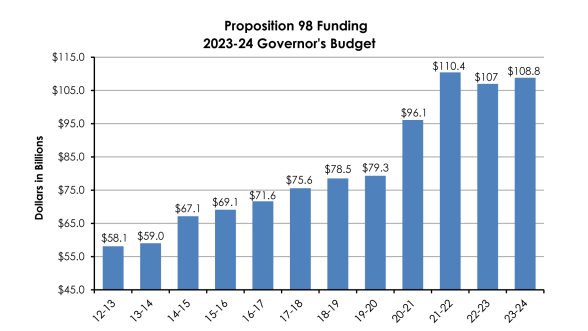
So you’ve decided you want to become a teacher in California. Congratulations, you have chosen a noble profession.
I have been a teacher for over 25 years. The job has some great perks, but it’s not all fun and games. Most of the time, I have found joy in teaching, but it is a challenging career. It seems to get more difficult every year. (See the post about teacher burnout)
You must meet these requirements in California to become a teacher in 2023.
Bachelor’s degree:
You must have a bachelor’s degree from an accredited college or university. It doesn’t matter which school you attend as long as it’s accredited. I have been on the hiring committee many times, and the school you attend has little to no effect on hiring decisions. Your skills at interviewing do matter. Teachers want to see that you are the kind of person who will work well with others. I recommend new teachers try substitute teaching to build relationships and see which schools best fit them.
Teacher preparation program:
You must complete a teacher preparation program that the California Commission accredits on Teacher Credentialing (CTC). You can begin your teacher preparation while getting your bachelor’s degree. This way, some classes can count for your credential and degree. Take caution, though; most school districts pay teachers more based on the number of accredited college units taken after they receive a Bachelor’s Degree. By taking teacher credential classes before getting your degree, you are not accumulating units that will help you earn more. Most teacher preparation programs include a year of student teaching. These programs usually take two years to complete. I completed my teaching program and Master’s degree in an accelerated program at National University. Enrolling in a program that you can complete quickly can be costly but worthwhile. Alternatively, many school districts have teacher internship programs.
Basic skills requirement (CBEST):
You must pass the California Basic Educational Skills Test (CBEST) or another exam that meets the basic skills requirement. The CBEST covers basic high-school skills everyone should know to get a high-school diploma. I was not feeling well when I took the CBEST and took too much cold medicine, which impaired my test-taking ability. Still, the CBEST was easy to pass. I have often wondered why this test is even necessary because all teachers are required to have a Bachelor’s Degree. I suppose it’s so politicians can say teachers in the state are well qualified.
CSET:
When I first became a teacher, I had to pass the MSAT. It was a difficult test that teachers had to pass if their bachelor’s degree was not in General Education. My degree is in History. I know many people who took the MCAT numerous times before passing. I was fortunate to pass this test on my first try. Today the MSAT has been replaced with the CSET. If you want to become a secondary school teacher, you will likely need to pass an additional portion of the CSET for the subject you are looking to teach. See for more CSET information.
Subject Matter Competence:
You must demonstrate subject matter competence by passing the appropriate California Subject Examinations for Teachers (CSET) or completing a state-approved subject matter preparation program.
Teaching Performance Assessment:
You must complete a teaching performance assessment such as the California Teaching Performance Assessment (CalTPA) or the Performance Assessment for California Teachers (PACT).
This test is based on knowledge of teaching performance expectations (TPEs). See for more CAlTPA information.
Background clearance:
You must pass a background check and meet other requirements for good moral character.
Age and Language Requirements:
Additionally, you must be at least 18 years old, meet the basic health requirements, and have the ability to communicate effectively in English.
Apply to Teach:
Go through these steps, and you are ready to be a teacher. When you are ready, apply to join a school district. Most districts have a simple interview process where they will review that you have all of the requirements to teach. Once hired by the school district, you may choose to become a substitute teacher or submit your resume to schools for consideration of full-time employment. Each school can select its full-time staff. It is a good idea to get to know the teachers at the school of your choice. This will help you know if and when teaching positions become available, and it will help you get the job.
Clear Your Credential:
You must obtain a clear teaching credential by completing a teacher induction program or meeting other requirements.
Teacher Induction Program:
The California Teacher Induction Program (previously BTSA, Beginning Teacher Support and Assessment) helps incoming teachers get their California preliminary teaching certification.
The program is for pre-credentialed instructors in their first two years. Teachers in the program engage with a certified support provider to create a personalized professional development and support plan. The support provider helps the teacher set goals, evaluate their teaching, and devise improvement techniques.
The California Teacher Induction Program provides individualized support, professional development, and continuous teacher assessments. School officials provide comments and resources to program teachers.
New instructors earning their preliminary teaching certification are encouraged to join the California Teacher Induction Program. New teachers will learn how to become competent and successful educators in a friendly and collaborative environment.
Recent Posts

The Essential Role of Parental Involvement in Education: A Teacher’s Perspective
As a teacher and a coach of a Vex Robotics Team, I’ve witnessed firsthand the transformative power of parental involvement in both academic achievement and personal development of students. Today, I want to share with you my personal experiences and empirical evidence that underscores the importance of this partnership.

Innovative Strategies for Integrating Technology into Traditional Math Lessons
In the digital age, the integration of technology into educational practices has become not just a novelty but a necessity. As educators, our goal is to prepare students for a world that is increasingly reliant on technology, not only for communication and entertainment but for solving complex problems and facilitating innovation. This is particularly true in the subject of mathematics, where traditional teaching methods can sometimes fail to capture the interest and imagination of students. By integrating technology into math lessons, educators can make the subject more engaging, interactive, and accessible to students with diverse learning styles.

Technology is Transforming How We Learn
In 2023, the convergence of artificial intelligence (AI), gamification, and technology in education has been transformative, reshaping the learning experience for students and educators alike. Alongside platforms like IXL.com and specific education-related learning apps, YouTube has emerged as a powerful force in altering the way people consume information and learn.

California’s Budget Challenges: Impact on Schools & Strategies
The recent Fiscal Outlook by The Legislative Analyst’s Office for the state disclosed that a severe revenue drop in 2022-23 has resulted in a substantial budget deficit of $68 billion. According to current state law and policy, the Legislature must address this deficit in the upcoming budget process.
California Governor Gavin Newsom could opt to declare a fiscal emergency to address the budget shortfall, granting access to $24 billion from previously accumulated budget surpluses.

Nurturing Success: A Journey into Vex Robotics with a School Robotics Team
In September of 2023, I found myself faced with a unique challenge – keeping our school robotics team alive. With a limited budget and no available school staff volunteers, the future of our Vex Robotics Team hung in the balance. Little did I know, this experience would turn into a remarkable journey of collaboration, learning, and success.

10 Tips to Help Students Stay Organized for the Start of School
Starting a new school year can be exciting and overwhelming at the same time. With new classes, schedules, assignments, and activities, students need to stay organized to set themselves up for success. Here are ten tips to help students start the school year off on the right foot:
Setting up a study schedule is essential for managing your time well. Encourage students to make a weekly schedule with time set aside for each subject and for activities outside of school.

